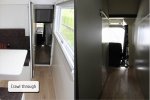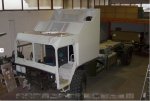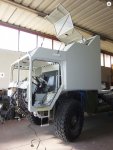Hi Steve and Bev,
OK, now I understand.
It's an interesting solution; wonder if it has ever been tried?
It makes perfect sense. After all, why build a completely new habitation box, if instead one can buy a fifth-wheel camper-box ready-made and in good condition for only half the price (or less) of a new one. Note that you could probably still mount a stripped-down, "wheel-less" camper-box on top of a pivoting three-point sub-frame, and thereby go with a more standard sort of twisting truck frame. But as you suggest, if you want the camper box to cantilever over the cab, as per a fifth wheel, then you need a torsion-free frame. So a used MAN-KAT is the obvious choice.
If you can pull it off, at the very least you will have a very original vehicle: a fully integrated MAN-KAT conversion, with slide-outs. As far as I know, no such vehicle currently exists.
As for engine access, in the older MAN-KATs the engine locates behind the cab, not under it, as per the newer HX models. The true technology successor of the MAN KAT is the SX-series, not the HX-series. HX models are really just militarized TGA trucks. Whereas SX-series models have torsion-free frames, and the engine mounts behind the cab, just like the older MAN-KATs. See earlier in this thread, where all of this is explained in mind-numbing detail…..:sombrero:
Now as far as I know the MAN KAT cab must still tilt forwards to provide comprehensive engine-access. But the engine locates to one side, allowing a spare tire to sit lengthwise on the other side. So in the MAN KAT conversion for sale that was posted earlier in this thread, they removed the tire, and put in a corridor that directly links the cab with the camper box:

For more images, see
http://www.expedition-trucks.com/brokers/man-kat-6x6-expedition-truck ,
http://www.doleoni.com/wp/en/ , and
http://www.doleoni.com/wp/#portfolio .
This corridor seems very original, because in large expedition vehicles usually the cab links to the camper-box via a kind of "bendy-bus", bellows-type rubber pass-through. It has to be bendy, because in most large expedition vehicles the underlying frame twists. When driving over rough terrain the cab goes one way, and the camper-box goes the other.... Whereas the corridor pictured above is decidedly
not a bellows-type pass-through. As near as I can tell, this corridor is full height where it meets the camper box, but becomes crouching-height immediately behind the seats in the cab, probably because the the ceiling of the MAN KAT cab is so low. MAN KATs are military vehicles that must have low cab ceilings, to allow air-transportability. But this consideration does not apply for expedition motorhomes, so you could probably configure the corridor differently, by raising the ceiling of the MAN KAT cab.
In the next week or so I plan on doing a series of posts that cover this camper in detail, because it is one of the most "integrated" MAN-KAT conversion I've yet seen, and certainly one of the most elegant and sophisticated. However, there does still seem to be a break between the cab and the camper, perhaps so as to allow the cab to tilt forwards, or raise vertically?:






Sure, it's nothing like the huge gap with bendy-bus pass-through that characterizes most large expedition campers. But it's a break nonetheless.
I am not certain whether the cab of this MAN-KAT tilts forwards or rises vertically. But note that the additional pieces that surround the cab were constructed separately from the camper box:


On the other hand, the following image suggests that the engine, or at least the air-intake on the roof, can be accessed from the top of the cab:

And who knows, perhaps enough access to the engine could be provided via panels that open on the sides, such that the cab would no longer have to be tilted forwards or otherwise raised? Because again, in a MAN KAT the engine sits
behind the cab, not under it.
I don't know the answer to any of these questions. One regular participant on ExPo who might know the answers, is
egn. You might try writing
egn a private message, if he does not respond in this thread in the next week or two. Or you might also try writing to DeLeoni, who did the conversion, at:
- FEDERICA GASPARATO
- 0039-347-2286045
- via Roma 80/B - 31020 Villorba (TV)
- info@doleoni.com
Many thanks for posting in this thread, because yours is a
very interesting idea, one that never occurred to me.
Just curious: what fifth-wheel campers have you looked into? Which ones appeal to you the most, and why? Please feel free to post at length in this thread, because your whole line of thinking is completely relevant to its central concern or "theme". And if you do write to Doleoni, please let us know their response here on ExPo, OK?
All best wishes,
Biotect










































